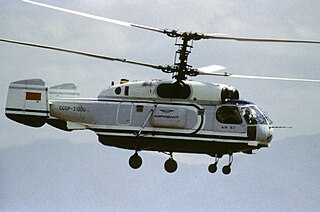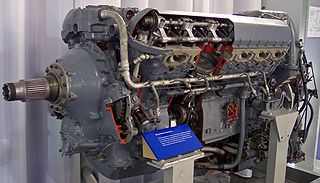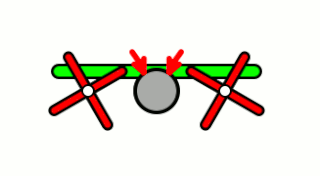
A turboprop is a turbine engine that drives an aircraft propeller.

A propfan, also called an open rotor engine, open fan engine or unducted fan, is a type of aircraft engine related in concept to both the turboprop and turbofan, but distinct from both. The design is intended to offer the speed and performance of a turbofan, with the fuel economy of a turboprop. A propfan is typically designed with a large number of short, highly twisted blades, similar to the (ducted) fan in a turbofan engine. For this reason, the propfan has been variously described as an "unducted fan" (UDF) or an "ultra-high-bypass (UHB) turbofan".

The Europrop International TP400-D6 is an 11,000 shp (8,200 kW) powerplant, developed and produced by Europrop International for the Airbus A400M Atlas military transport aircraft. The TP400 is the most powerful turboprop in service using a single propeller; only the Kuznetsov NK-12 from Russia and Progress D-27 from Ukraine, using contra-rotating propellers, is larger.

Contra-rotating, also referred to as coaxial contra-rotating, is a technique whereby parts of a mechanism rotate in opposite directions about a common axis, usually to minimise the effect of torque. Examples include some aircraft propellers, resulting in the maximum power of a single piston or turboprop engine to drive two propellers in opposite rotation. Contra-rotating propellers are also common in some marine transmission systems, in particular for large speed boats with planing hulls. Two propellers are arranged one behind the other, and power is transferred from the engine via planetary gear transmission. The configuration can also be used in helicopter designs termed coaxial rotors, where similar issues and principles of torque apply.

The Armstrong Siddeley Double Mamba is a turboprop engine design developed in the late 1940s of around 3,000–4,000 hp (2,200–3,000 kW). It was used mostly on the Fairey Gannet anti-submarine aircraft developed for the Fleet Air Arm of the Royal Navy.

The Rolls-Royce Griffon is a British 37-litre capacity, 60-degree V-12, liquid-cooled aero engine designed and built by Rolls-Royce Limited. In keeping with company convention, the Griffon was named after a bird of prey, in this case the griffon vulture.
The critical engine of a multi-engine fixed-wing aircraft is the engine that, in the event of failure, would most adversely affect the performance or handling abilities of an aircraft. On propeller aircraft, there is a difference in the remaining yawing moments after failure of the left or the right (outboard) engine when all propellers rotate in the same direction due to the P-factor. On turbojet and turbofan twin-engine aircraft, there usually is no difference between the yawing moments after failure of a left or right engine in no-wind condition.
The Kuznetsov Design Bureau was a Russian design bureau for aircraft engines, administrated in Soviet times by Nikolai Dmitriyevich Kuznetsov. It was also known as (G)NPO Trud and Kuybyshev Engine Design Bureau (KKBM).

The Kuznetsov NK-12 is a Soviet turboprop engine of the 1950s, designed by the Kuznetsov design bureau. The NK-12 drives two large four-bladed contra-rotating propellers, 5.6 m (18 ft) diameter (NK-12MA), and 6.2 m (20 ft) diameter (NK-12MV). It is the most powerful turboprop engine to enter service.

The General Electric GE36 was an experimental aircraft engine, a hybrid between a turbofan and a turboprop, known as an unducted fan (UDF) or propfan. The GE36 was developed by General Electric Aircraft Engines, with its CFM International equal partner Snecma taking a 35 percent share of development. Development was cancelled in 1989.

A coaxial-rotor aircraft is an aircraft whose rotors are mounted one above the other on concentric shafts, with the same axis of rotation, but turning in opposite directions (contra-rotating).
The Yakovlev Yak-46 was a proposed aircraft design based on the Yak-42 with two contra-rotating propellers on the propfan located at the rear. The specification of the Samara turbofans was in the 11,000 kg thrust range. Though proposed in the 1990s, production of the Yak-46 never commenced.

P-factor, also known as asymmetric blade effect and asymmetric disc effect, is an aerodynamic phenomenon experienced by a moving propeller, wherein the propeller's center of thrust moves off-center when the aircraft is at a high angle of attack. This shift in the location of the center of thrust will exert a yawing moment on the aircraft, causing it to yaw slightly to one side. A rudder input is required to counteract the yawing tendency.

In aeronautics, an aircraft propeller, also called an airscrew, converts rotary motion from an engine or other power source into a swirling slipstream which pushes the propeller forwards or backwards. It comprises a rotating power-driven hub, to which are attached several radial airfoil-section blades such that the whole assembly rotates about a longitudinal axis. The blade pitch may be fixed, manually variable to a few set positions, or of the automatically variable "constant-speed" type.

Counter-rotating propellers (CRP) are propellers which turn in opposite directions to each other. They are used on some twin- and multi-engine propeller-driven aircraft.

In fluid dynamics, disk loading or disc loading is the average pressure change across an actuator disk, such as an airscrew. Airscrews with a relatively low disk loading are typically called rotors, including helicopter main rotors and tail rotors; propellers typically have a higher disk loading. The V-22 Osprey tiltrotor aircraft has a high disk loading relative to a helicopter in the hover mode, but a relatively low disk loading in fixed-wing mode compared to a turboprop aircraft.

The Pratt & Whitney/Allison 578-DX was an experimental aircraft engine, a hybrid between a turbofan and a turboprop known as a propfan. The engine was designed in the 1980s to power proposed propfan aircraft such as the Boeing 7J7 and the MD-91 and MD-92 derivatives of the McDonnell Douglas MD-80. As of 2019, it is still one of only four different contra-rotating propfan engines to have flown in service or in flight testing.
The Coax-P is a contra-rotating propeller developed by NeuraJet of Senftenbach, Austria and Sun Flightcraft of Innsbruck, Austria for the Rotax 503 and Rotax 582 aircraft engines for use on ultralight aircraft.

The Progress D-236 was an experimental aircraft engine, a hybrid between a turbofan and a turboprop known as a propfan. Also known as the Lotarev D-236T, the three-shaft geared engine was designed in the 1980s and 1990s to power proposed propfan aircraft such as the Tupolev Tu-334, Ilyushin Il-118, and Ilyushin Il-88.

The Kuznetsov NK-93 was a civilian aircraft engine, a hybrid between a turbofan and a turboprop known as a propfan. The engine was also unique in having a separate duct around the contra-rotating propellers, as most other propfans are unducted. Once described in a respected aviation encyclopedia as "potentially the most fuel-efficient aircraft jet engine ever to be tested", the NK-93 was targeted for derivatives of Soviet/Russian airliners such as the Ilyushin Il-96, Tupolev Tu-204, and Tupolev Tu-330. Five in-flight engine tests were conducted on the NK-93 from December 2006 to December 2008.





















